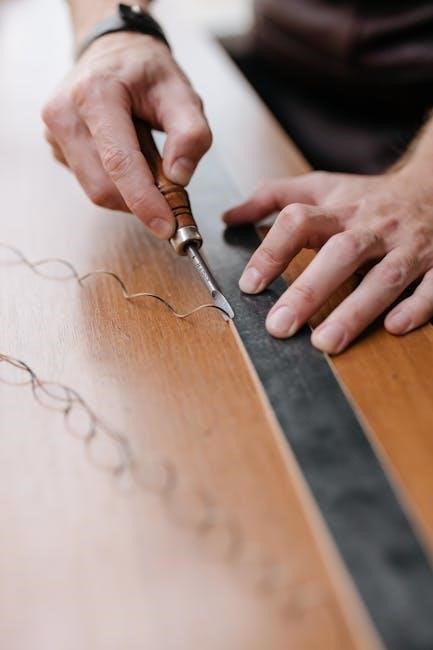Properly installing child seat harnesses is crucial for ensuring safety and comfort. Correctly securing the straps prevents accidents and ensures optimal protection for children while traveling.
Importance of Properly Installing Child Seat Harnesses
Properly installing child seat harnesses is essential for ensuring a child’s safety and comfort during travel. Correct installation prevents accidents‚ reduces injury risks‚ and guarantees the seat functions as intended; Loose or improperly adjusted straps can lead to serious harm‚ even in minor collisions. According to experts‚ nearly half of child seats are installed incorrectly‚ emphasizing the need for meticulous attention to detail. Proper installation not only saves lives but also ensures the child remains comfortable and secure‚ fostering a safe traveling environment. Always follow manufacturer guidelines to avoid common mistakes and ensure optimal protection for your child.
Legal Requirements for Child Safety Seats
Child safety seats are legally required in most countries to protect children during travel. Laws mandate the use of age- and weight-appropriate seats‚ with specific guidelines for rear-facing and forward-facing positions. Non-compliance can result in fines or penalties. In the U.S.‚ for example‚ all states require children under a certain age or weight to use a federally approved car seat. The American Academy of Pediatrics recommends rear-facing seats until age two or reaching the seat’s height/weight limit. Adhering to these regulations ensures compliance with safety standards and minimizes risks during accidents. Always check local laws for specific requirements.
Consequences of Improper Harness Installation
Improper installation of child seat harnesses can lead to severe consequences‚ including increased risk of injury or ejection during an accident. Loose straps may fail to restrain the child‚ causing greater impact force. Additionally‚ incorrect positioning of the chest clip can lead to internal injuries. Inadequate tightening of the harness may result in the child being thrown from the seat. Such negligence can also lead to legal consequences for violating child safety laws. Proper installation is critical to ensure the child’s safety and protection in the event of sudden stops or collisions. Always follow the manufacturer’s guidelines to avoid these risks.

Preparation Steps
Before installing‚ read the manual‚ ensure the seat fits your child’s size‚ and prepare your vehicle by clearing space and gathering necessary tools.
Gathering Necessary Tools and Materials
Gathering the right tools and materials is crucial for a safe installation. Start with the child seat manual‚ vehicle manual‚ and a seat belt or ISOFIX connectors. Ensure you have a firm‚ level surface. Check for ISOFIX anchors in your vehicle. A wrench or screwdriver may be needed for base installation. Keep a soft cloth handy to clean surfaces. Verify all straps and buckles are intact. Having these items ready ensures a smooth process and prevents delays; Always double-check that all components are compatible with your vehicle and child seat model for optimal safety and security.
Choosing the Right Child Safety Seat
Selecting the appropriate child safety seat is essential for your child’s protection. Consider your child’s age‚ weight‚ and height to ensure compatibility. Rear-facing seats are best for infants‚ while forward-facing seats suit older children. Check for features like adjustable harnesses and impact protection. Ensure the seat fits your vehicle by reviewing both the car and seat manuals. Look for certifications like ECE R44 or FMVSS 213 to confirm compliance with safety standards. Always prioritize a seat that offers optimal support and alignment with your child’s growth stages for maximum safety and comfort.
Positioning the Child Safety Seat in the Vehicle
Correctly positioning the child safety seat ensures optimal protection and proper harness function. Place the seat in the back seat‚ ideally in the middle for maximum safety. Align the seat with the vehicle’s seat‚ ensuring it sits flat and even. Secure the base firmly against the vehicle seat to prevent movement. Adjust the harness straps to fit your child snugly‚ with the chest clip at armpit level. Tighten the seat belt or ISOFIX straps until the seat is stable. Check the seat’s fit by gently shaking it; minimal movement ensures proper installation. Always consult your vehicle and seat manuals for specific guidance.

Installation Using Vehicle Seat Belt
Install the child seat using the vehicle’s seat belt by placing it firmly‚ routing the belt correctly‚ and tightening it for a secure‚ stable fit.
Securing the Base of the Child Seat
To secure the base‚ place it firmly against the vehicle seat‚ ensuring it is snug and even. Use the vehicle’s seat belt to fasten it in place‚ following the manufacturer’s instructions. Tighten the belt until the base feels stable and immovable. For added stability‚ some seats may require tucking the belt firmly into the designated grooves or using a locking mechanism. Double-check that the base does not move side to side or front to back. If your vehicle has a rear seat bench‚ ensure the base is centered and evenly supported. Proper securing ensures the seat remains stable during travel.
Adjusting the Harness Straps
To adjust the harness straps‚ start by pulling the straps to remove any slack. Ensure the shoulder straps are at or slightly below your child’s shoulder level for rear-facing seats or at shoulder level for forward-facing seats. The chest clip should be positioned at armpit level to properly distribute force. Tighten the straps until the harness fits snugly against your child’s body. Check the fit by attempting to pinch the straps; if you can’t pinch any material‚ the fit is correct. Proper adjustment ensures maximum safety and comfort for your child during travel.
Tightening the Seat Belt
To tighten the seat belt for the child seat‚ thread the vehicle’s seat belt through the designated path on the child seat. Buckle the seat belt and pull the belt to remove any slack. Hold the child seat firmly in place while tightening the belt. Continue pulling the belt until it is snug against the child seat‚ ensuring no movement. Check the seat belt’s stability by gently shaking the child seat; it should feel secure. If using a seat belt lock‚ ensure it is engaged to prevent loosening. Always refer to your vehicle’s manual for specific seat belt tightening guidance.
Checking for Proper Fit and Stability
After securing the child seat‚ perform a thorough check to ensure proper fit and stability. Gently shake the seat side-to-side and front-to-back to confirm it doesn’t move excessively. Visually inspect the harness straps to ensure they are snug‚ evenly aligned‚ and free from twists. Press down firmly on the seat cushion to verify it is snug against the vehicle’s seat. Check that the chest clip is at armpit level and the straps are neither too loose nor too tight. Finally‚ have the child sit in the seat to ensure it remains stable and secure during use.

Installation Using ISOFIX System
Locate the ISOFIX anchors in your vehicle‚ usually marked with an ISOFIX logo. Attach the child seat’s connectors to these anchors firmly. Tighten the ISOFIX straps to ensure a snug fit. Check the seat’s stability by gently rocking it to ensure no movement. Follow the manufacturer’s instructions for proper installation and safety.
Locating ISOFIX Anchors in the Vehicle
ISOFIX anchors are metal brackets built into the vehicle’s rear seats. They are typically marked with an ISOFIX logo or labeled in the vehicle’s manual. To locate them‚ lift the rear seat cushions or remove the seat covers to expose the anchors. They are usually found between the seat back and cushion. Some vehicles may have ISOFIX anchors hidden under flaps or marked with symbols. Always refer to your vehicle’s manual for exact locations. Once found‚ ensure they are clean and free of debris before attaching the child seat connectors. Proper alignment is crucial for safe installation.
Attaching the Child Seat to ISOFIX Anchors
To attach the child seat‚ align the ISOFIX connectors on the base of the seat with the vehicle’s anchors. Gently push the seat toward the anchors until they click securely into place. Ensure the connectors are fully engaged and not twisted. Next‚ tighten the ISOFIX straps evenly to remove any slack‚ ensuring the seat is firmly attached. Check the alignment and stability by gently rocking the seat—it should not move more than 1 inch side to side. Proper attachment ensures optimal safety and protection for the child in the event of sudden stops or collisions.
Tightening the ISOFIX Straps
After attaching the child seat to the ISOFIX anchors‚ locate the tightening straps on the seat’s base. Pull each strap firmly to remove any slack‚ ensuring the seat is snug against the vehicle seat. Continue tightening until the straps are taut and the seat feels stable. Check the tightness by attempting to move the seat—it should not shift. Finally‚ tug on the straps to confirm they are secure and properly tightened. This step ensures the child seat remains firmly in place‚ providing maximum protection during travel.
Verifying ISOFIX Installation Stability
After securing the child seat using the ISOFIX system‚ grasp the seat firmly and attempt to move it side to side and forward/backward. Ensure there is minimal to no movement‚ indicating a stable installation. Check the ISOFIX indicators‚ such as color-changing mechanisms or audible clicks‚ to confirm proper attachment. Consult the car seat manual for specific indicators. Additionally‚ ensure the ISOFIX straps are tightly secured. Repeat the stability check by applying moderate force to confirm the seat remains firmly in place. This verification step is crucial for ensuring the child’s safety during travel.

Adjusting the Harness Straps
Properly tighten the straps by pulling the harness to ensure a snug fit‚ adjusting shoulder height‚ and positioning the chest clip at armpit level for optimal safety.
Height Adjustment of Shoulder Straps
Ensure the shoulder straps are at or slightly below your child’s shoulders. Locate the adjustment mechanism‚ typically at the back or base of the seat. Pull the straps to thread them through the correct height slot. Tighten firmly to secure. The straps should lie flat against your child’s chest‚ with no twisting. If your seat has a no-rethread harness‚ use the adjustment lever to lower or raise the straps. Always refer to your seat’s manual for specific instructions. Proper height ensures the harness provides optimal protection in the event of sudden stops or collisions.
Ensuring Proper Chest Clip Positioning
Position the chest clip at armpit level‚ directly across your child’s chest. It should not sit too high (near the neck) or too low (on the stomach). Adjust the clip so it lies snugly against the chest‚ ensuring proper restraint. If your child wears bulky clothing‚ like winter coats‚ adjust the clip accordingly. The chest clip should be tight enough to keep the harness straps in place but not so tight that it causes discomfort. Always refer to the manufacturer’s instructions for specific guidance on chest clip placement for your child’s safety seat.
Tightening the Harness

To tighten the harness‚ pull the straps firmly to remove any slack while the child is seated. Ensure the straps lie flat against the body without twisting. Once snug‚ check the fit by attempting to pinch the strap material; if you can’t pinch any excess‚ it’s properly tightened. Avoid overtightening‚ as this can cause discomfort. Regularly inspect the harness to ensure it remains secure‚ especially as the child grows. Always refer to your car seat manual for specific tightening instructions‚ as methods may vary slightly by model. Proper harness tension is critical for optimal safety in the event of sudden stops or collisions.
Checking for Any Slack in the Straps
After tightening the harness‚ inspect the straps for any visible slack. Grip the shoulder straps and pull gently to ensure they don’t move excessively. Perform the pinch test: pinch the strap material at shoulder height. If you can’t hold any excess fabric‚ the fit is correct. Check the hip straps similarly‚ ensuring they’re snug against the child’s body. Excess slack can compromise safety in an accident. Regularly recheck the straps as the child grows or if the seat is moved between vehicles. Proper fit ensures maximum protection and prevents potential risks during sudden stops or collisions.

Additional Safety Measures
Additional safety measures ensure optimal protection for children. Use rear-facing seats for infants‚ adjust headrests‚ and ensure comfort. Check weight and height limits for proper fit and safety.
Using a Rear-Facing Seat for Infants
Using a rear-facing seat for infants is essential for their safety. It provides better support for their neck and spine in the event of sudden stops or collisions. Infants should remain rear-facing until they reach the maximum weight or height limit specified by the seat’s manufacturer‚ typically around 2-4 years old. Ensure the seat is installed at the correct angle‚ usually indicated by a built-in level or angle indicator. Avoid adding extra padding or toys that could interfere with the harness. Always consult your vehicle’s manual for compatibility and installation guidelines. Rear-facing seats significantly reduce injury risks.
Headrest Adjustment for Optimal Protection
Adjusting the headrest is crucial for optimal protection. Ensure the headrest is level with your child’s ears and shoulders for proper support. For rear-facing seats‚ the harness straps should be at or below the child’s shoulders. In forward-facing seats‚ they should be at or above. The headrest should not be too high or low‚ as this can leave the child’s head unprotected. Incorrect positioning can lead to injury in a crash. Always refer to your vehicle’s manual for specific headrest adjustment guidelines‚ as features may vary. Proper alignment ensures the harness functions correctly in the event of sudden stops or impacts.
Ensuring the Child’s Comfort
Ensuring the child’s comfort is essential for a pleasant journey. Dress your child in lightweight‚ breathable clothing to avoid overheating. Avoid bulky items like jackets‚ as they can interfere with the harness fit. Adjust the seat’s padding and fabric to suit your child’s preferences. Ensure the child’s legs are positioned comfortably‚ with support if needed. Avoid overtightening the harness‚ as this can cause discomfort. Regularly check the seat’s temperature‚ especially in sunny or cold conditions. A comfortable child is less likely to fuss during trips‚ making the journey enjoyable for everyone. Always ensure comfort without compromising safety standards.

Tips for Avoiding Common Mistakes
Always ensure harness straps are snug and chest clips are correctly positioned. Double-check tightness and alignment to prevent errors. Use manufacturer guides for precise installation.
Loose Harness Straps
Loose harness straps are a common mistake that can compromise safety. Always check straps before each use to ensure they fit snugly around the child. Tighten straps by pulling the shoulder harness upward and securing the chest clip at armpit level. Use the vehicle’s seatbelt or ISOFIX system to anchor the seat firmly. Regularly inspect straps for wear or damage. Ensure no slack remains‚ as loose straps can fail to restrain the child properly in sudden stops or crashes. Proper tightening ensures optimal protection and reduces the risk of injury.
Incorrect Chest Clip Placement
Incorrect chest clip placement is a critical error that can endanger a child. The chest clip should be positioned at the child’s armpit level‚ ensuring proper restraint. Placing it too high or too low can lead to injury or ejection during a crash. Always adjust the clip snugly against the chest‚ avoiding gaps. Check the clip’s position every time the child is secured. Failure to align it correctly can compromise the harness’s effectiveness‚ increasing the risk of internal injuries or the child slipping out of the seat. Proper placement is essential for optimal protection and safety.
Overlooking Seat Belt or ISOFIX Tightening
One of the most common mistakes is failing to tighten the seat belt or ISOFIX straps properly. Loose installation can cause the child seat to move during a crash‚ reducing its protective effectiveness. Always ensure the seat belt or ISOFIX straps are snug and tightly secured to the vehicle. Check for any movement by gently shaking the seat. If it wobbles‚ tighten the straps further. Proper tightening ensures the seat remains stable‚ providing optimal protection. Neglecting this step can lead to inadequate restraint‚ increasing the risk of injury or ejection during an accident. Always verify tightness before each use.

Maintenance and Inspection
Regularly inspect harness straps for frays or damage. Clean the seat with mild soap and water. Check expiration dates and replace worn or expired parts. Ensure all components function correctly for safe use.
Regularly Checking Harness Straps for Wear
Inspect harness straps monthly for signs of wear‚ such as frays‚ cuts‚ or fading. Loosen straps to examine both sides thoroughly. Bend straps to check for cracks or weakened fibers. Ensure no hardware is damaged or corroded; Compare straps to replacement parts if unsure about their condition. Avoid using harsh chemicals‚ as they may degrade materials. If damage is found‚ replace straps immediately. Refer to the manual for guidance on proper inspection techniques. Regular checks ensure the harness remains safe and secure‚ protecting the child in the event of sudden stops or collisions.
Cleaning the Child Safety Seat
Cleaning the child safety seat is essential for maintaining hygiene and ensuring its longevity. Start by removing any loose debris from the seat and harness. Use a mild soap solution and a soft cloth to wipe down the fabric and plastic components. Avoid harsh chemicals‚ bleach‚ or abrasive cleaners‚ as they may damage the materials. For tough stains‚ gently scrub with a damp cloth. Allow the seat to air dry completely before reuse. Regular cleaning prevents the buildup of dirt and odors‚ ensuring a safe and comfortable environment for your child.
- Avoid machine washing or soaking the seat.
- Never use bleach or harsh detergents.
- Always air dry to prevent moisture buildup.
Replacing Harness Straps if Damaged
If the harness straps of your child’s car seat are damaged‚ replace them immediately to ensure safety. Inspect straps for frays‚ cuts‚ or excessive wear. Follow the manufacturer’s instructions for replacement‚ as procedures vary by model. Use only original or approved replacement parts to maintain certification standards. Tighten the new straps securely and test for proper fit. If unsure‚ consult a certified technician or the seat’s manual. Regular inspections and timely replacements are critical to protect your child in the event of sudden stops or accidents. Always prioritize your child’s safety by maintaining the seat’s integrity.

Special Considerations
Special considerations include installing seats in different vehicle types‚ such as SUVs or sedans‚ and handling varying weight and height limits for children. Always ensure the seat fits multiple vehicles safely.
- Vehicle type affects installation‚ requiring adjustments for SUVs‚ sedans‚ or trucks.
- Weight and height limits vary; choose seats matching your child’s size.
- Using seats in multiple vehicles demands careful reinstallation each time.
Installing in Different Vehicle Types
When installing a child safety seat‚ consider the vehicle type‚ as differences in design affect placement. Sedans‚ SUVs‚ and trucks have varying seat shapes and anchor locations. Always check the vehicle manual for ISOFIX or seat belt compatibility. In smaller cars‚ space may be limited‚ requiring more precise adjustments. Larger vehicles offer more flexibility but may need additional tightening for stability. Ensure the seat fits snugly‚ regardless of vehicle size‚ and test the installation in multiple vehicles if necessary. Adjustability is key for optimal safety across different vehicle types. Always follow the manufacturer’s guidelines for specific vehicle-seat compatibility.
Handling Different Child Weight and Height Limits
When installing a child safety seat‚ it’s crucial to consider the child’s weight and height to ensure proper fit and safety. Always check the seat’s specifications to match the child’s size. For smaller children‚ rear-facing seats are essential‚ while forward-facing seats are appropriate once weight and height limits are exceeded. Adjust the harness straps to fit snugly‚ with shoulder straps at or below the child’s shoulders and the chest clip at armpit level. Regularly monitor the child’s growth and upgrade the seat as needed to maintain optimal protection. Ensure the seat’s installation aligns with both the vehicle and seat manufacturer’s guidelines for varying weight and height ranges.
Using the Child Safety Seat in Multiple Vehicles
When using a child safety seat in multiple vehicles‚ ensure compatibility with each vehicle’s specifications. Always reinstall the seat and harness system in the new vehicle‚ following the manufacturer’s instructions. Check the seat belt or ISOFIX system for proper fit and tightness. Adjust the harness straps and chest clip to maintain optimal protection. Regularly verify the seat’s stability and alignment in each vehicle. If moving the seat frequently‚ consider owning multiple bases or seats for convenience. Always refer to the vehicle and seat manuals for specific guidance. Proper installation in each vehicle is crucial for your child’s safety on the road.
Proper installation of child seat harnesses is crucial for your child’s safety. Always follow the final checklist and encourage others to adhere to safety guidelines. Visit local authorities or manufacturers’ websites for additional support and updates on child seat regulations.
Final Checklist for Correct Installation
To ensure your child’s safety seat is properly installed‚ follow this final checklist:
- Verify the seat is securely positioned and the base is tightly fastened.
- Check that harness straps are correctly adjusted‚ with the chest clip at armpit level.
- Ensure the harness is snug‚ with no slack‚ and the seat belt or ISOFIX system is tightly secured.
- Confirm the seat does not move more than 1 inch side-to-side or front-to-back.
- Double-check all straps and clips for proper alignment and tightness.
- Perform a final visual inspection and test stability by gently shaking the seat.
This checklist ensures a safe and correct installation‚ protecting your child in all situations.
Encouraging Proper Installation Practices
Proper installation of child seat harnesses is crucial for ensuring a child’s safety while traveling. Parents and caregivers should always follow the manufacturer’s instructions and double-check the fit of the seat and harness. Educating others about the importance of correct installation can save lives. Encourage regular inspections of the seat and harness to ensure they remain secure. Sharing tips‚ such as ensuring the harness is snug‚ the chest clip is at armpit level‚ and the seat is tightly fitted‚ can help others avoid common mistakes. Community workshops or online resources can also provide hands-on guidance to promote proper installation practices.
Resources for Further Assistance
For additional guidance on installing child seat harnesses‚ consult your vehicle’s manual or the child seat manufacturer’s instructions. The National Highway Traffic Safety Administration (NHTSA) offers a Car Seat Finder tool and instructional videos. The Insurance Institute for Highway Safety (IIHS) provides detailed installation tips. Local fire stations or community centers often host free car seat installation clinics. If unsure‚ certified technicians can assist. Always refer to trusted sources to ensure your child’s safety. These resources will help confirm proper installation and address specific concerns.

Be First to Comment